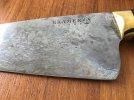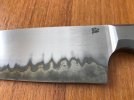- Joined
- Nov 27, 2002
- Messages
- 2,087
HELL i still believe the smith imparts part of himself in to the blade as he forges it :)[/QUOTE said:And you'd be right..!
The BladeForums.com 2024 Traditional Knife is available! Price is $250 ea (shipped within CONUS).
Order here: https://www.bladeforums.com/help/2024-traditional/
HELL i still believe the smith imparts part of himself in to the blade as he forges it :)[/QUOTE said:And you'd be right..!
A good smith will set their steel up for optimum structure before heat treat, regardless of whether the steel is forged or stock removal. Forging helps steels like certain batches of cru forge v or aldo's 52100. Forging heat breaks up the course spheroidized structure as does normalizing at proper temps for the steel. After normalizing, there will be grain refinement and sometimes fine spheroidizing. This affects the soak time needed to get the steel into solution for quenching. Forging or stock removal offer no advantage over the other if you get the best structure pre austentize/quench. You can more easily damage the steel irreparably through forging though.
Of course it is - don't take me so literally.
You know that I meant that after forging, the steel can be in such a disarray that it needs to be put back at square 1 so that it can then be taken forward into whatever the next step would be best for that steel.
Forging may help in that direction. It may not.
The list of conditions and steel types is lengthy, to say the least.
My point is for buyers to ask their potential makers what they do and why.
Simply getting a piece of steel hot and beating it with a hammer doesn't make it better.
Like I said earlier, forging offers far more ways to ruin a decent piece of steel than to help it.
it's up to the buyer to sort out his makers and find the ones who understand this.
"The most a black smith can ever hope for is to end up with as good a piece of steel as the one he started with."


